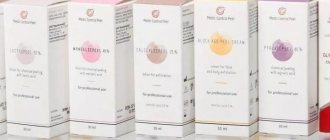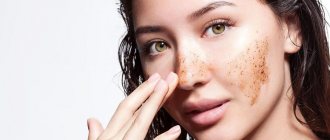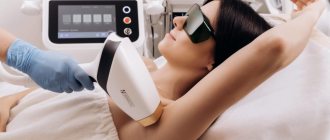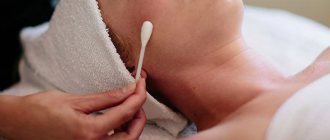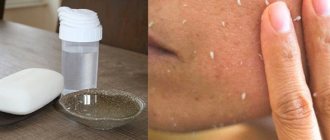From this article you will learn:
- What are the causes of pigmentation formation?
- What are the different types of depigmenting peels?
- How to choose such a peeling
- How to care for your skin after depigmentation peeling
- How to make it at home
- What are the preventative measures for pigmentation?
Depigmentation peeling is a currently popular way to combat so-called age spots - small areas of darker color on the skin, the appearance of which is caused by disruptions in the production of melanin. Thanks to this procedure, you can even out your complexion. This occurs due to the exfoliation of dead epidermal cells, which leads to the formation of new ones. To understand whether depigmentation peeling is effective and safe, you need to take a closer look at the features of this procedure.
Reasons for the formation of pigmentation
First you need to figure out what causes changes in the pigment of the skin of the face and body.
Cosmetologists point to the following factors:
- Negative effects of ultraviolet radiation on the skin.
- Disorders of the liver or thyroid gland.
- Impact of hormonal drugs.
- Various diseases of the genitourinary system.
- Pregnancy.
- Age-related changes.
- Effect of antibiotics on the body.
- Using low-quality cosmetics.
- Insufficient amount of nutrients.
To determine exactly what led to the change in skin color in a particular case, it is necessary to undergo a series of tests. Having identified the cause of the problem, you can select the most effective means of preventing the formation of age spots and get rid of existing ones.
Read the material on the topic: How to get rid of dark spots on the face
Opinion of cosmetologists
Cosmetologists note the high relevance of the problem of facial pigmentation, especially in the summer, when a large number of freckles appear under the influence of sunlight. It is important not only to get rid of them seasonally, but also to take comprehensive measures on a regular basis.
Peels are recommended to be carried out in courses. Chemical and hardware methods provide a good effect.
The most common depigmenting peels
Chemical or acidic
As the name suggests, this type of peeling is based on the use of acid. Most often, glycolic, salicylic, retinol, azelaic, and lactic acids are used to influence dead cells.
The effect of the method is to free the upper layer of the epidermis from pigmentation. It allows you to cleanse pores, remove blackheads, pimples and acne. After the examination, the cosmetologist will determine the required number of sessions. The use of acid peels is very helpful in getting rid of dark and light spots on the skin.
The most popular types of procedures that help even out facial tone:
- TCA peeling. It can only be performed in a professional cosmetology salon. The procedure involves injecting 20–35% trichloroacetic acid under the upper layer of the dermis, which, penetrating deeply into the skin, removes pigmentation and smoothes wrinkles.
- Peeling based on retinolic acid. Recognized as the most effective. Usually one or two sessions are enough, after which redness forms at the site of age spots, and after a while it acquires the same shade as your own skin tone. The main component of this type of peeling is retinol (vitamin A). In addition to its depigmenting properties, the procedure has a lifting effect, helps smooth out scars and scars, and evens out the tone of the upper layer of the epidermis.
- Glycolic acid, introduced under the top layer of skin, has an anti-inflammatory effect, helps get rid of wrinkles, makes the skin more hydrated, and increases elastin production. The spots covering the face and body gradually disappear.
Advantages of the procedure:
- effectively fights pigment spots and other skin imperfections;
- versatility: with the help of glycolic acid you can even out your tone, get rid of scars, wrinkles and acne;
- long lasting effect.
Contraindications:
- allergy to the components of the product;
- unhealed wounds;
- pregnancy;
- lactation period;
- inflammatory process;
- herpes;
- exposure to active sun during the rehabilitation period.
The duration of one course is usually eight sessions of 15–20 minutes each.
Mechanical
This type of peeling is based on the destruction and removal of the upper layer of the epidermis through the use of small solid particles of various substances when treating the skin. Most often used:
- seaweed;
- pieces of raspberry or apricot kernels;
- crushed corals.
This is the most gentle method of depigmentation of facial skin, virtually eliminating its damage. Several procedures can be performed within a month without the risk of injury.
Read the material on the topic: Chemical peeling of the face: your skin will breathe a new breath!
Radio wave
This is a completely safe and painless procedure. The basis of the method is the impact of radio frequency waves of varying intensity on individual areas of the skin.
Under the influence of radio waves of a certain length, epidermal cells are destroyed and evaporated, due to which the process of formation of new young cells is activated, tissues are restored.
This peeling can significantly improve the condition of the skin, even out the color, remove spots without damaging the dermis and does not require surgical intervention. The procedure is performed using a high-tech device that precisely affects the skin at a strictly defined level. This approach completely eliminates the penetration of the destructive wave into other tissues. Thanks to this, there is no risk of scars, stretch marks and other unpleasant consequences.
The radio wave depigmentation peeling process consists of the following steps:
- A radio pulse of a certain range affects the deep layers of the epidermis.
- The cells are heated.
- The process of reducing old protein fibers and breaking down fats accelerates.
- The mechanism of tissue repair and the production of its own collagen is activated.
The effect of deep radio wave peeling is comparable to the effect of laser facial cleansing. The procedure is quite lengthy: the average time it takes can be an hour or more. At the same time, it allows you to achieve excellent results: the dermis becomes smoother and tighter, hyperpigmentation disappears, and pores become narrower.
In some clinics and medical centers you can find another name for this technique - radio wave lifting, which is explained by its ability to activate collagen production, optimize water balance, and increase skin elasticity.
But it is worth remembering that, as with any other type of manipulation, before starting the procedure you need to make sure that there are no contraindications to its implementation.
Sequence of operations:
- Cleansing skin that will be exposed to radio waves. A special approach requires the preparation of problem areas of the dermis.
- Application of a special composition, the use of which is necessary to create a certain contact environment that ensures the effectiveness of radio wave influence, and also makes the process safe.
- Using electrodes attached to the treated areas of the skin, an electric current is carried out, which heats the tissue to the desired temperature. Overheating of cells or burns of the dermis is eliminated through the use of a special thermometer.
To perform radio wave depigmentation peeling, a device equipped with various attachments with recesses around which electrodes are located is used. An electromagnetic wave occurs in the recesses through the created vacuum. The attachments allow for targeted heating of specific areas of the skin.
Today you can choose a portable device for performing radio wave peeling at home.
Recommended articles on the topic:
- How to properly care for your skin
- How to remove wrinkles on the face: the most effective methods
- Microcurrent facial therapy is a beneficial treatment for your skin
Laser depigmentation peeling
This method is one of the most effective in combating uneven skin color. Even one session allows you to achieve quite tangible results. The laser targets a specific area of the skin, removing dead cells and stimulating natural collagen synthesis. Usually, 6-8 sessions are enough to completely get rid of age spots.
Advantages of laser depigmentation peeling:
- complete security;
- absolute painlessness;
- rejuvenating effect;
- complete removal of pigment spots.
Read material on the topic: Lightening age spots: 11 beauty recipes
Soreness
Superficial peeling does not cause pain. During the mid-type procedure, burning and tingling may occur, which do not require additional anesthesia. The deep method is a more complex procedure. It requires general anesthesia and observation by a doctor.
Laser treatment is called one of the most painless. Thanks to the cooling system, the patient only feels warmth and a slight tingling sensation during the session. In case of overly sensitive skin, the cosmetologist will suggest applying a local anesthetic.
How to choose the right depigmentation peeling
When choosing the most suitable method for removing age spots, you must consider:
- absence of chronic diseases, allergies;
- general state of functioning of the body;
- hormonal balance;
- planning a baby or pregnancy;
- optimal cost of the procedure;
- season.
So, now we have found out that to even out skin color, you can use either acidic or hardware methods, which today are quite effective and relatively safe. Moreover, all of these methods of influence have a number of useful properties.
Any procedure that requires the use of fairly aggressive components is best left to specialists. If you still prefer to carry out depigmentation peeling at home, be sure to consult with professionals before the session and clarify the possible risks and options for dealing with them. To choose the best method for you, study the reviews of masters and those who already have experience using one or another method.
Read material on the topic: Retinoic yellow peeling done by Hollywood stars
Precautionary measures
Peeling, like any other cosmetic procedure, has a number of contraindications:
- inflammatory skin diseases (dermatitis, acne, etc.);
- violation of skin integrity (wounds, abrasions, burns);
- allergic manifestations;
- malignant processes in the body;
- diseases of the cardiovascular system;
- acute viral infections;
- herpes in the active phase;
- metabolic disease;
- period of pregnancy and breastfeeding.
Do not be alarmed if intense peeling of the skin begins 2-3 days after the session. This is a normal process. The main thing is not to rip off the scales and regularly use moisturizer. Redness may also appear, which usually goes away within 3-5 days.
Symptoms that should alert you and cause you to see a doctor include:
- severe itching;
- soreness;
- increase in body temperature.
You also need to visit a specialist if the redness does not subside after a few days, but, on the contrary, intensifies.
Skin care after peeling
Features of skin care after peeling depend not only on the chosen option, but also on individual indicators. The rehabilitation period and basic nuances of care take into account recommendations for cosmetic procedures, the type of dermis, the method of performing the manipulation and other factors. At the same time, each specialist has his own secrets and tips that will help achieve maximum effect and quickly restore the skin after manipulation. In addition, there are universal recommendations from professionals. Let's take a look at them.
After depigmentation peeling, it is prohibited to:
- For two days, use cleansers when washing your face and rub your face;
- apply cream, masks or any other cosmetic products;
- go outside, sunbathe, cool your facial skin very much;
- for two weeks, go to the bathhouse, hammam, sauna, take a hot shower or bath, visit the solarium, gym, swimming pool.
Can be used:
- hypoallergenic foam or cleansing gel for problem skin;
- To restore immunity, a cream with panthenol is recommended;
- If it is not possible to avoid sun exposure to the skin, it is necessary to use SPF products with an index of at least 40.
The cosmetologist will make a list of products that should be used during the first two weeks after peeling. The use of other products can greatly harm the skin and reduce the effect of the procedure. The main task during this period is to normalize lipid and water balance, avoid inflammation and maximally moisturize even the deep layers of the epidermis. During this time, you need to stop using decorative cosmetics, so as not to cause clogging of the pores, and the usual cosmetics.
Special care should be taken outdoors. Now you need to use products with SPF filters, and also apply protective cream during frost and wind. Don't give up accessories that are useful in sunny weather, such as sunglasses, Panama hats and wide-brimmed hats.
If, some time after the procedure, discomfort, severe irritation, swelling or another reaction appears that the cosmetologist did not warn about, inform the specialist to avoid the occurrence and spread of infection.
Typically, the skin restoration process takes 14-15 days. With proper care and good condition of the epidermis, this period may be shorter, but it is better not to take risks and wait the necessary time to avoid unpleasant consequences.
Read material on the topic: Dark spots on the face - why they appear and how to get rid of them
Minimally invasive procedure “BB GLOW TREATMENT”
A cosmetologist uses a special device - a darmapen. There are contraindications, consultation is required
This is a hardware procedure that whitens the skin and has a healing effect. She fights freckles, post-acne, age spots and uneven complexion. As a result of using “bb glow treatment”, pores are narrowed, fine wrinkles are straightened, the skin becomes moisturized and radiant.
Depigmenting peeling at home
Modern cosmetology allows you to carry out the depigmentation peeling procedure at home. This is much cheaper, but often less effective.
Exfoliating products for use at home do not have an immediate whitening effect. Therefore, when using scrubs, in any case, you need to use other products.
Let's take a look at some homemade peeling recipes to even out your skin tone.
- Citrus.
As a base, you can use lemon, lime or grapefruit juice with added sugar. The mixture is mixed well and applied to the face. The mask must be washed off with warm water after 10 minutes.
- Oatmeal classic peeling.
Grind a quarter cup of oatmeal and add three to four tablespoons of lemon juice. The resulting scrub is rubbed into the skin. The mask is washed off after drying.
- Depigmenting peeling based on badyagi and hydrogen peroxide.
Badyagu and hydrogen peroxide are mixed in a 1:1 ratio. The resulting mass is rubbed in and left on the face for about 10 minutes.
When performing a depigmentation peeling procedure at home, be sure to cleanse your skin before applying the product and moisturize after. Maximum time and attention should be devoted to preparing and restoring the dermis.
Read material on the topic: How to care for facial skin: home care and salon treatments
Complications and contraindications
Superficial chemical peeling has much fewer contraindications than medium or deep ones, but they also exist. The procedure is not recommended for people with overly sensitive skin. There should be no damage (wounds, scratches, purulent rashes) in the areas of chemical treatment.
Contraindications for medium, deep peeling and laser treatment are similar. The procedure should not be performed on people with:
- serious cardiovascular pathologies;
- diabetes mellitus;
- various acute skin diseases (dermatitis, psoriasis, dermatosis);
- epilepsy;
- autoimmune disorders;
- oncology;
- ARVI;
- pregnancy.
Cosmetologists strongly recommend not to neglect these contraindications.
Prevention of pigmentation
Depigmenting peeling is a product aimed at evening out the complexion of the skin. But you can avoid the appearance of age spots by following two rules:
- Maintaining vitamin balance. Vitamin A (retinol) promotes skin pigmentation, vitamin C (ascorbic acid) – lightening. A balanced intake of these nutrients along with food can solve the problem of age spots. But it is important not to limit your intake of vitamins - this can lead to vitamin deficiency, which will have a detrimental effect on your overall health.
- Skin exposure to ultraviolet rays should be avoided or minimized. The use of SPF products will help with this.
Nowadays, you no longer have to spend a lot of time performing complex and unpleasant procedures at home. It is much easier to seek help from real professionals - the Veronika Herba beauty and health center, equipped with effective and modern equipment.
Why clients choose Veronika Herba Beauty and Health Center:
- This is a beauty center where you can take care of yourself at a reasonable cost, while your face and/or body will be treated not by an ordinary cosmetologist, but by one of the best dermatologists in Moscow. This is a completely different, higher level of service!
- You can receive qualified help at any time convenient for you. The beauty center is open from 9:00 to 21:00, seven days a week. The main thing is to agree with your doctor in advance on the date and time of your appointment.
Sign up for a consultation with a specialist by phone +7 (495) 085-15-13
, and you will see for yourself!


